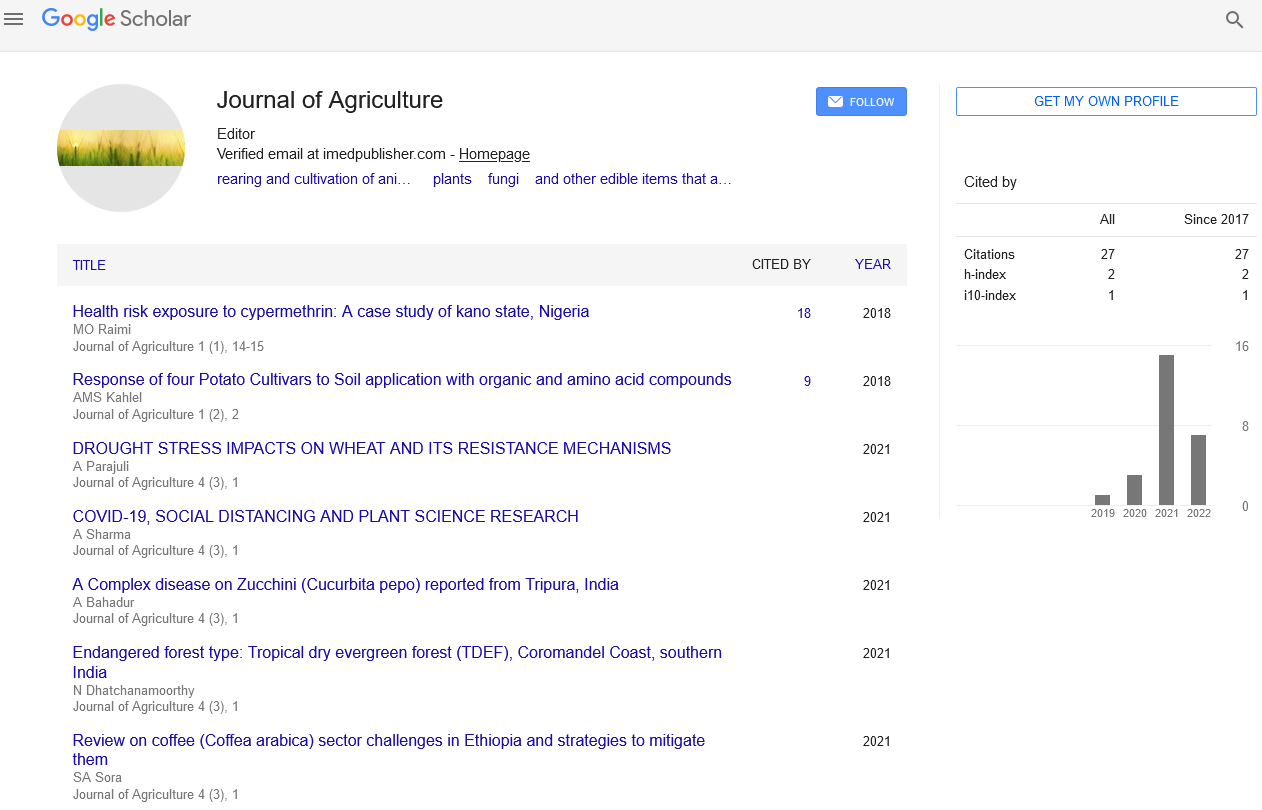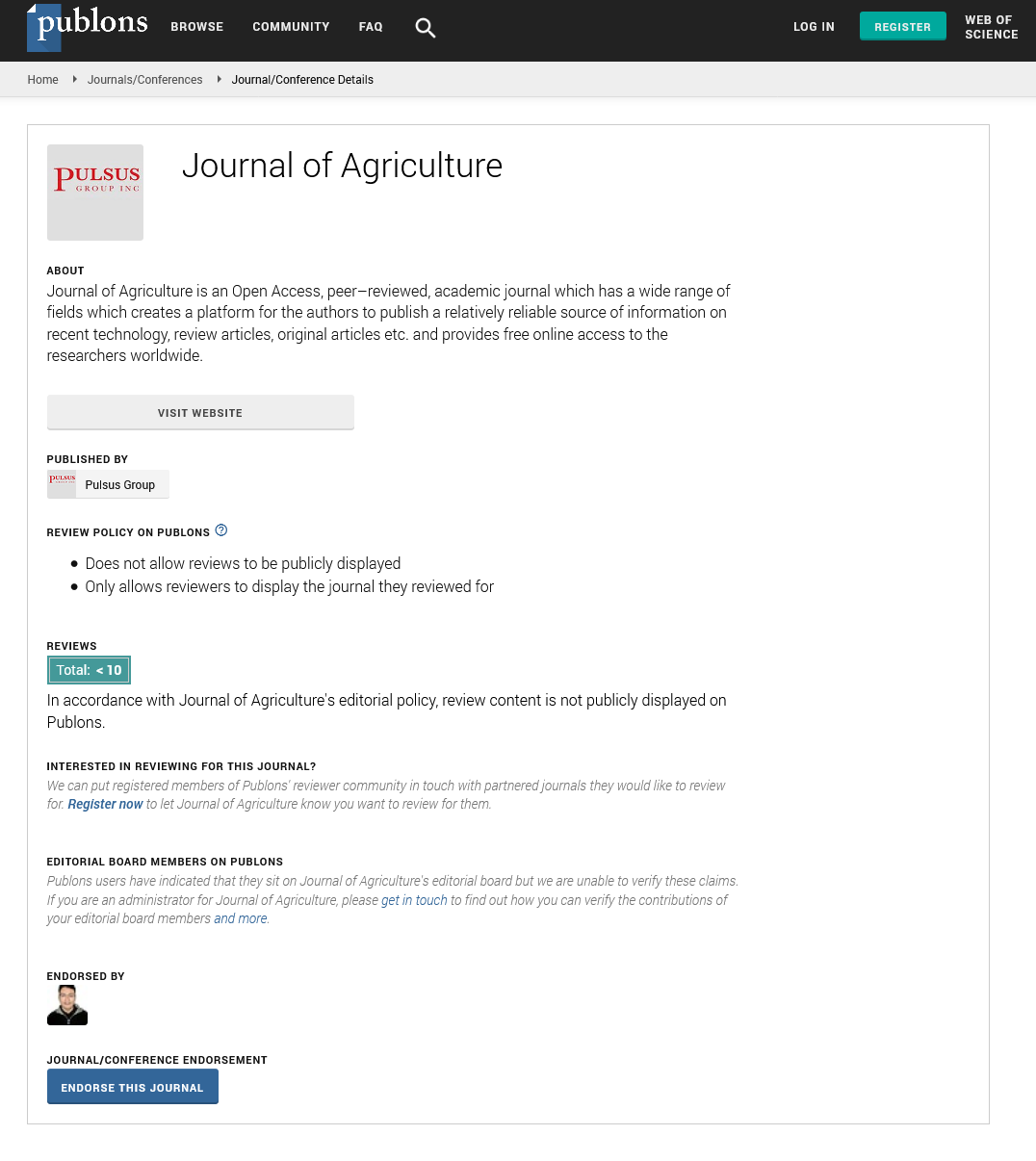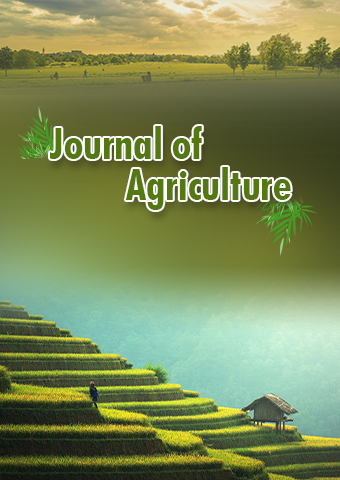Editorial - Journal of Agriculture (2023) Volume 6, Issue 4
Utilising optical sensing, high-throughput phenotyping of many scales of plant leaf morphological, physiological, and biochemical properties
Michael Popp*
Department of Biology, Lund University, Ecology Building, Sweden
Department of Biology, Lund University, Ecology Building, Sweden
E-mail: Michaep5@gmail.com
Received: 01-Aug-2023, Manuscript No. jagri-23-108632; Editor assigned: 03-Aug-2023, Pre-QC No. jagri-23-108632 (PQ); Reviewed: 17- Aug-2023, QC No. jagri-23-108632; Revised: 22-Aug-2023, Manuscript No. jagri-23-108632 (R); Published: 29-Aug-2023; DOI: 10.37532/ jagri.2023.6(4).115-117
Abstract
Advancements in agricultural research have increasingly relied on technological innovations to boost crop productivity and sustainability. One such breakthrough is the application of optical sensing technology for high-throughput phenotyping of plant leaf properties. This article explores the revolutionary impact of optical sensing in the field of plant research, enabling the rapid assessment of various c, physiological, and biochemical attributes at different scales. From individual leaves to entire plant populations, the integration of optical sensors has ushered in a new era of precision agriculture, accelerating the breeding and selection of superior crop varieties and enhancing our understanding of plant-environment interactions.
Keywords
Agricultural research • Environment interactions • Crop productivity • Phenotype
Introduction
As the global population continues to rise, ensuring food security remains a critical challenge. Optimizing crop production while minimizing resource usage has become a key focus for agricultural scientists. The development of high-throughput phenotyping techniques using optical sensing has revolutionized plant research by offering a non-destructive and rapid means of characterizing plant traits at multiple scales. Optical Sensing Technology in Plant Phenotyping Optical sensing involves the use of various spectral ranges, such as visible, near-infrared, and hyperspectral bands, to capture detailed information about plant characteristics. These sensors measure reflectance, transmittance, or fluorescence of light by plant tissues, revealing valuable insights into their morphology, physiology, and biochemistry [1].
Morphological Traits Optical sensing facilitates the precise quantification of morphological traits such as leaf area, length, width, and shape. By employing high-resolution imaging techniques, researchers can efficiently analyze variations in leaf size and architecture across different genotypes and environmental conditions. Physiological Parameters The ability to assess plant physiological parameters is crucial for understanding plant health and performance. Optical sensors can determine chlorophyll content, photosynthetic efficiency, stomata conductance, and water potential without causing any damage to the plant. These real-time measurements enable scientists to monitor plant responses to stressors like drought, nutrient deficiencies, or pests [2].
Biochemical Properties the biochemical composition of plant leaves, including pigments, proteins, and secondary metabolites, significantly impacts their nutritional value and stress tolerance. Optical sensing, particularly hyperspectral analysis, allows for non-destructive quantification of these compounds, facilitating the selection of crop varieties with desirable nutritional profiles and resilience. High-Throughput Phenotyping Platforms To cope with the vast amounts of data generated by optical sensors, automated highthroughput phenotyping platforms have been developed [3]. These platforms can process large numbers of samples simultaneously, enabling researchers to study entire plant populations and evaluate their responses to diverse environmental conditions in a time-efficient manner.
Advantages and Challenges The integration of optical sensing in plant phenotyping offers numerous advantages, including non-destructive measurements, rapid data acquisition, and potential for continuous monitoring. However, challenges such as data analysis, standardization of protocols, and sensor calibration must be addressed to ensure the reliability and reproducibility of results. Applications in Crop Breeding and Precision Agriculture The utilization of optical sensing has expedited crop breeding programs by enabling the identification of superior genotypes with desirable traits. Additionally, in precision agriculture, this technology facilitates site-specific management strategies, optimizing resource allocation and promoting sustainable farming practices. Future Perspectives As optical sensing technology continues to advance, the integration of artificial intelligence and machine learning algorithms will further enhance data analysis and interpretation. Moreover, miniaturization of sensors and advancements in unmanned aerial vehicle (UAV) technology will expand the scope of high-throughput phenotyping beyond the field level [4,5].
Optimization of data processing methods
With the continuous enrichment of data collected by plant phenotype information monitoring systems, the demands for processing of phenotypic data will also increase drastically, including image processing, feature extraction and model building. Optical sensors are readily affected by the light environment, and an unstable light environment will reduce the accuracy of acquired images and spectral information. It is desirable to improve the accuracy and efficiency of phenotypic data processing, as well as flexibility when light and background changes. Optimization of phenotypic data processing requires a combination of multidisciplinary knowledge [6]. The establishment of a multidisciplinary team of experts and decision support system can lead to real-time high throughput monitoring of phenotypic information and high precision and efficient phenotypic data processing [7].
Forest phenotype
Existing plant leaf phenotypic information analysis technology is used mostly for crop phenotypic analysis. Compared with crops, trees are characterized by large height, large numbers of leaves, and long growth cycle [8]. It is more challenging to obtain complete and accurate leaf phenotypic information for trees. The shape and characteristics of the leaves of coniferous forest species further increase the difficulty of collecting phenotypic information. The measurement of leaf angular distribution for trees with large and curvy leaves could be very time-consuming, if not impossible [174]. However, forests have high ecological and economic value. It is desirable to increase research on phenotyping of forest trees, break through the research bottleneck of coniferous species, and develop phenotype monitoring systems suitable for forests [9, 10].
Conclusion
Optical sensing has emerged as a transformative tool for high-throughput phenotyping of plant leaf morphological, physiological, and biochemical properties. By enabling comprehensive and non-destructive data acquisition at multiple scales, this technology has revolutionized plant research, paving the way for improved crop productivity and sustainable agricultural practices in the face of global challenges. Plant leaf morphological traits are generally acquired with visible-light cameras, while physiological and biochemical traits are usually acquired via spectral imaging technology. Thermal imaging is frequently used for stomata conductance and water content parameters associated with drought stress. Spectral imaging technology offers abundant data and high efficiency, but it is expensive, redundant and complex to process, and especially when it is acquired by a UAV, complex offline processing of data is required. Visible light imaging technology has the advantages of low cost and simple data processing, but its low spectral resolution has limited its use in the analysis of leaf physiological and biochemical parameters. Other modern imaging technologies, such as CT, OCT, and terahertz imaging, are superior in efficiency and accuracy, but their high cost prevents their widespread use. Multi-sensor fusion technology can combine the advantages of various imaging technologies for leaf trait estimation. As the cost of imaging sensors continues to decline, sensor combination is anticipated to play a more important role in leaf phenotyping.
References
- Reverter M, Sarter S, Caruso D et al. Aquaculture at the crossroads of global warming and antimicrobial resistance. NatCommun.11(1), 1870-1879 (2020).
- Delgado CL, Wada N, Rosegrant MW et al. Outlook for fish to 2020: meeting global demand. Intl food policy res inst.15, (2003).
- Kiran P, Adi J. Aquaculture role in global food security with nutritional value: a review.TranslAnimSci. 3(2), 903-910 (2019).
- Asiedu K, Berchie FKE, Iddrisu S et al. Prospects and sustainability of aquaculture development in Ghana, West Africa.Cogent Food & Agricultur.3(1), 1349531 (2017).
- Ogello EO, Mlingi FT, Nyonje BM et al. Can integrated livestock-fish culture be a solution to East Afircan's food insecurity? A Review.African J Food Agric Nutr Dev.13 (4), 8058-8078 (2013).
- Ogello EO, JM Munguti. Aquaculture: a promising solution for food insecurity, poverty and malnutrition in Kenya.African J Food Agric Nutr Dev.16(4), 11331-11350 (2016).
- Nesar A, Thompson S, Giovanni M. Organic aquaculture productivity, environmental sustainability, and food security: insights from organic agriculture.Food Security.12, 1253-1267 (2020).
- Nesar A, Giovanni M, Turchini J. The evolution of the blue-green revolution of rice-fish cultivation for sustainable food production.Sustain Sci. 16(4), 1375-1390(2021).
- Jennings L, Simon M. Aquatic food security: insights into challenges and solutions from an analysis of interactions between fisheries, aquaculture, food safety, human health, fish and human welfare, economy and environment.Fish Fish. 17(4), 893-938 (2016).
- Ahmed N, Luong-V J. Can rice-fish farming provide food security in Bangladesh. Aquac Asia. 16, 12- 23 (2009).
Indexed at, Google Scholar, Crossref
Indexed at, Google Scholar, Crossref
Indexed at, Google Scholar, Crossref


